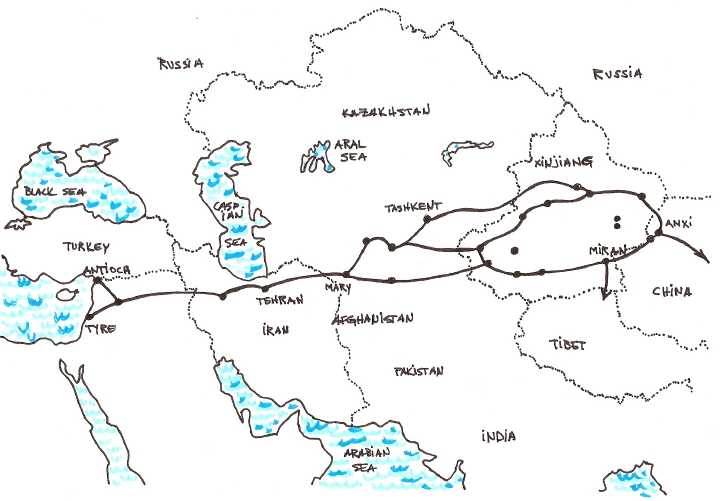
Bows and Arrows from Miran, China
by Andrew Hall and Jack Farrell
Originally published in the Journal of The Society of Archer-Antiquaries, #51, 2008, pp. 89-98.
Introduction
The Silk Road Museum, Seoul, South Korea contains two composite bows and nine arrows, reportedly found at the ancient town of Miran in Xinjiang, China.
Miran lies in the Tarim Basin on the southern route of the Silk Road around the formidable Taklamakan desert, towards the eastern end of the route. The town is noted for the Tibetan fort dating to the 8th to the 9th century which was excavated by Stein in 19061. It also has some earlier 3rd-5th century temples and stupas with Indian style fresco paintings.

Map 1 - Asia showing the Silk Roads around the Tarim basin detailed in Map 2.
The History of Miran
The first written documents on events in the Tarim Basin date from the 2nd century BC when the Han Dynasty Chinese started to expand their influence into the region. Everything before this, Chinese historians regard as prehistoric2.
Occupation of the region goes back much further than this, with finds of Caucasian mummies dating from approximately 4,000 years ago. A small number of Scythian-style bows dated to the middle of the first millennium have been found in burials.
From the first century BC Miran was part of the kingdom of Shanshan, which ruled the southeastern end of the Tarim basin from its capital of Yüni near Charkhlik (to the west of Miran)3. Shanshan was nominally under the control of the Chinese, but this control was variable at times4.
At the end of the second century Shanshan expanded to control the Qiemo and Jingjue (Niya) kingdoms to the west. This gave it control of most of the southern Silk Road as well as the link route to the northern road. Miran was also the entry point of the route into Tibet.
In the second century AD, the region fell under the cultural influence of the Kushan kingdom, which ruled an area stretching from northwest India and Pakistan through Afghanistan to the western end of the Tarim Basin. It was at this time that Miran developed as a centre of Buddhism5.
During the 4th C travel along the southern route of the Silk Road became more dangerous6 and the town of Miran appeared to have been abandoned as Shanshan fell into decline.
The southeastern Tarim Basin including Miran was taken over by the Tuyuhun in the mid 5th century. The Tuyuhun were a powerful Mongolic speaking people who flourished in the 4th-7th centuries, roaming the areas of modern Qinghai and Gansu.
The Tuyuhun were repeatedly attacked by the Tang Chinese, and were finally defeated by the Tibetan empire in the 8th century. The Tibetans went on to dominate Central Asia and invaded parts of China.
The Tibetans constructed a fort at Miran as part of a defensive network to help control the area and defend the nearby mountain pass into Tibet and the Qinghai route of the Silk Road into China7. The fort was abandoned at the end of the Tibetan dominance in the 9th century.
By the time of Stein’s visit in 1906, only a small farming settlement remained on the site.
The location of Miran and some other find sites mentioned below can be seen in Map 2.
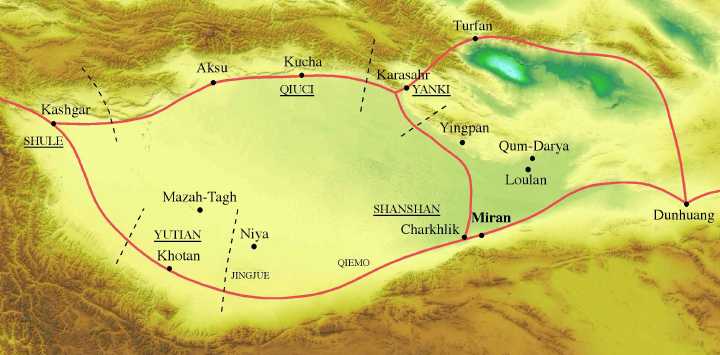
Map 2 - Topgraphic map of the Tarim Basin in the 2nd-3rd centuries showing the Silk Roads, states and some of the sites named in the text. Kingdom names are shown in upper case, towns and find sites in mixed case. Dominant kingdoms underlined and approximate boundaries of influence shown. Terrain map data: "CHGIS, Version 4" Cambridge: Harvard Yenching Institute, January 2007.
Dating the Finds
The good condition of the bows, and the similar damage that they had suffered at one end, indicates that they were probably found together in a burial. If so, this may indicate a multiple burial of related individuals, which is common in the royal burials at Niya8.
The Miran finds were unlikely to have been professionally excavated, so any dating should be treated as speculative.
The label in the case by the bows appears to indicate a 15-14 centuries B.C. date9, which is likely to be in error as these bows are Hunnic derived and that date predates the development of the Hunnic bow by more than a millennium.
A larger label in the cabinet describes the Shanshan kingdom. It is not known if there is any supporting evidence (for instance other datable finds) linking the bows to this period.
In general appearance (which will be discussed in more detail later), the bows look Hunnic derived, but have some differences from the finds at Niya and substantially different grips. A Shanshan date is probable but not certain10.
The Bows from Miran
The two bows are of the same asymmetric form, but differ in dimensions and siyah construction (see Figure 1).

Figure 1. The Miran bows in their display case
The heavier of the two bows is in the order of 60 in. round the curves, the other bow is slightly shorter due to shorter siyahs. Mid limb dimensions are about 2 x 5/8 in. for the heavier bow and 1 3/4 x 1/2 in. for the lighter. It is likely that the heavy bow was of substantially higher draw weight11.
Note that the thickness may be larger than when originally constructed due to the sinew “puffing up” as it deteriorated.
The two bows differ somewhat in the siyahs. The light bow has siyah side plates in a similar form to the earlier Hunnic weapons, but with side plates made from wood rather than bone. This bow measures approximately 1/2 in. thick by 5/16 in. wide at the nock.
The side plates have probably slipped relative to the core, as the core does not show a nock groove. It was not unusual for the side plates to project slightly past the core in the original constructions, so that the nock groove was only cut into the side plates.
The heavy bow does not have siyah side plates, but is of the same general form with a siyah length of about 9 inches (see Figure 2).
Both bows are backed with sinew almost to the nocks, with the nock grooves cut fairly close to the tips.

Figure 2. More intact siyahs of the two bows. (heavy bow at bottom of photo).
Both bows had suffered deterioration at one end, the light bow losing all its sinew there, such that the construction of the core is visible. The core had been bent to shape, probably using heat, and two strips of wood had been attached side-by-side to the back of the core to thicken and stiffen it (see Figure 3 and Figure 4).
Since it is noticeable how far down the limb the reinforcement strips extend, it is likely that a significant amount of the outer limb was non-bending.
The construction of the siyah of the heavier bow is not as visible as it survived in better condition. Only one piece of wood is visible at the tip.
Also notable is the width of the limb at the base of the siyah, the dimensions being about 1 7/8 x 3/4 in. for the heavy bow.

Figure 3. Damaged siyah showing core construction. (heavy bow at top of photo).

Figure 4. Another view of the damaged siyahs
Both bows were reinforced by spiral bindings of sinew reaching almost from nock to nock (see Figure 5 for light bow). The heavy bow has an additional longitudinal layer of sinew on top of these (see Figure 6), presumably to increase the draw weight some time after initial construction.
Both bows are covered by a paper thin membrane of a grey colour (not bark).
The heavy bow appears to be delaminating, and is tied together with string at the grip. This is probably a museum addition to prevent further separation of the layers.

Figure 5. Close up of the damaged back of the light bow showing longitudinal sinew covered by two spiral wrappings of sinew

Figure 6. Another view showing the spiral bindings with the heavy bow (behind) showing an extra longitudinal layer of sinew.
The grips are narrow and fairly short (see Figure 7 and Figure 8). There is no visible indication of bone grip plates being used.

Figure 7. Bow grips viewed from the bow back (rectangular object is suspected to be a plate from leather scale armour)

Figure 8. Another view of the bow grips showing more of the side as well as back.
The Arrows from Miran
Nine arrow shafts are displayed with the bows. All have had their points removed. One is four-fletched with 3 in. long and 3/8 in. high barred feathers in suspiciously good condition. None of the other arrows have any fletchings remaining. The shaft lengths are estimated to be approximately 30 to 32 in. All are of the typical form with barrelled shafts with bulbous nocks.
Several arrows are crested. One arrow has blue paint for 5/8 in. at the nock and for 1 1/4 in. at the point. It is about 7/16 in. in diameter in the centre, 5/16 at the point and 5/16 just in front of the bulbous nock. See Figure 9.
Another arrow has a band of blue paint just in front of the nock for about 1/2 in., a plain section of about 2 1/4 in. and a 1 1/4 in. red band. It has another blue band at the point. It is about 3/8 in. in the centre, 1/4 in. in front of the nock and abut 5/16 in. at the point.
Yet another arrow has a more complex cresting with a narrow blue band, a blue spiral to another blue band, a gap and another blue band, and finally a long red band terminated with a very narrow blue band.
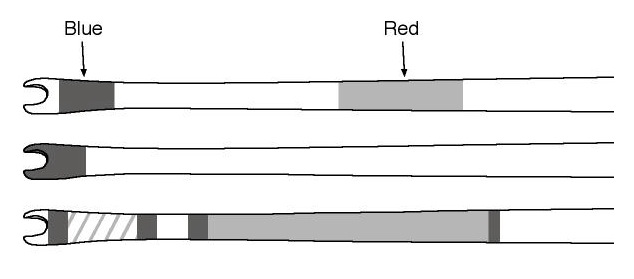
Figure 9. Cresting on some of the arrows(not to scale)
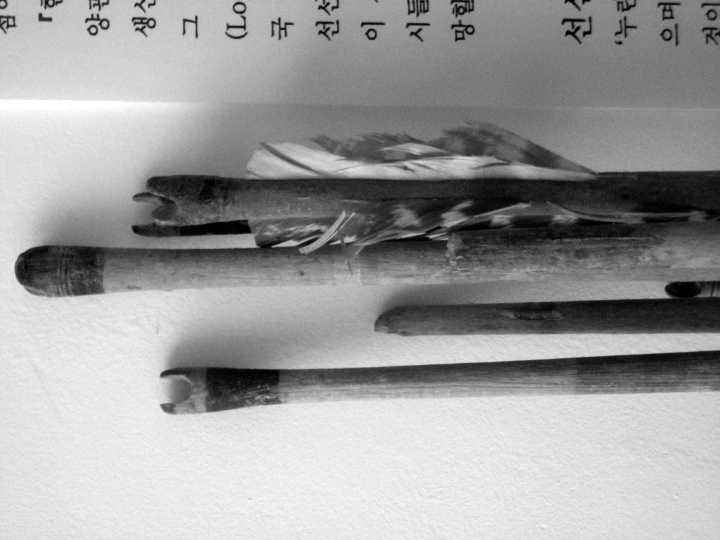
Figure 10. Nock ends of Miran arrows
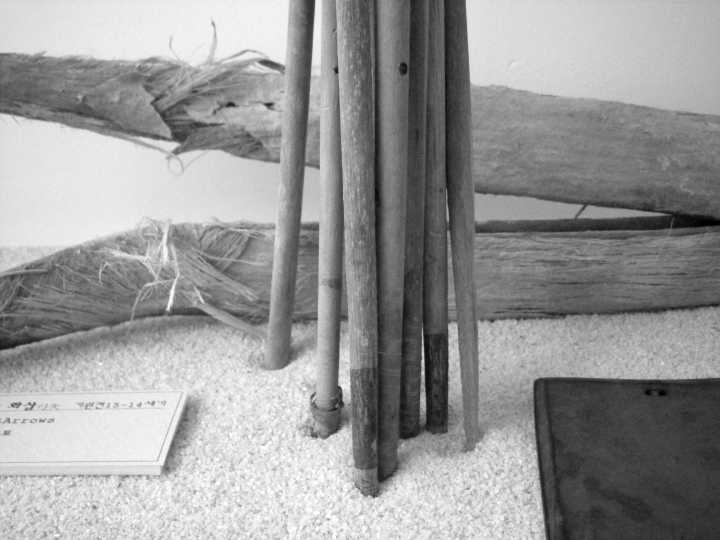
Figure 11. Point ends of Miran arrows (points missing)
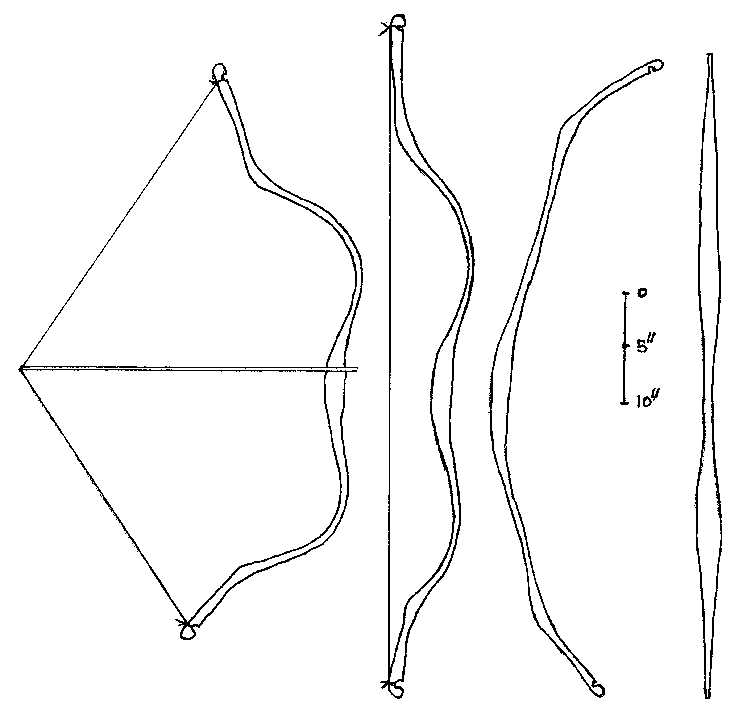
Figure 12. Reconstruction of the heavy bow (artist’s impression due to the inability to handle and measure the bow – scale approximate)
Other Finds from Miran
The archery related finds by Stein in 1908 were quite limited, consisting of a flat iron arrowhead and two fragments of reed arrow shaft, one with remains of fletching.
The Miran area was also excavated by Sven Hedin in the 1930s12. He excavated a graveyard some distance to the northeast of the fort. The grave finds were quite limited, probably dating to the Han dynasty (206 BC – 220 AD, this is the early part of the Shanshan period).
Other Archery Finds from the Shanshan Kingdom13
Qum-Darya
The Qum-Darya bow was found in a mass grave near Loulan and dates to about 200 AD14. It is a large, asymmetric bow of the Hunnic style. This was found intact but unfortunately smashed and most of the pieces lost in transit out of the desert. Only siyah fragments remain.
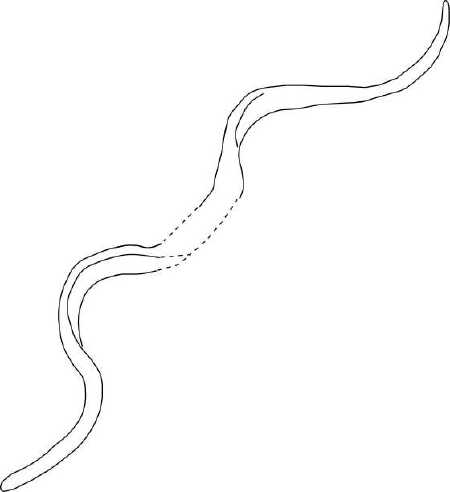
Figure 13. Approximate shape of Qum Darya bow when found (taken from a small and not very clear photo)
Yingpan
Yingpan is another site near Lop Nor. Two intact bows have been found, both dating to the 3rd century. One is a very asymmetric Hunnic style weapon (M19). The other is an almost unique composite with a strange transition between limb and siyah (M30).

Figure 14. Yingpan M19
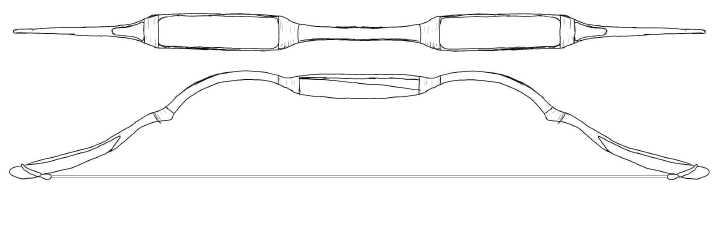
Figure 15. Yingpan M30
Niya
The Jingjue kingdom at Niya was originally an independent city state on the southern Silk Road. It was annexed by Shanshan at the end of the 2nd century AD15. A significant number of bows were found at this site, two large wide-limbed bows and two asymmetric Hunnic style bows were particularly well preserved. It is possible that the wide-limbed bows were from before the Shanshan take-over. 59MNM001 is dated to the Eastern Han dynasty (25-220 AD) and grave 95MN1M4 was carbon dated to the suspiciously early date of 260+/-60BC, with the asymmetric bows from the time just after the Shanshan took control (95MN1M8 at 206+/-60AD and 95MN1M3 at 215+/-60AD).

Figure 16. Niya 59MNM001
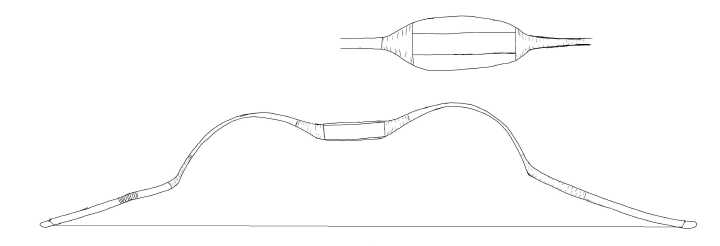
Figure 17. Niya 95MN1M4b

Figure 18. Niya 95MN1M8
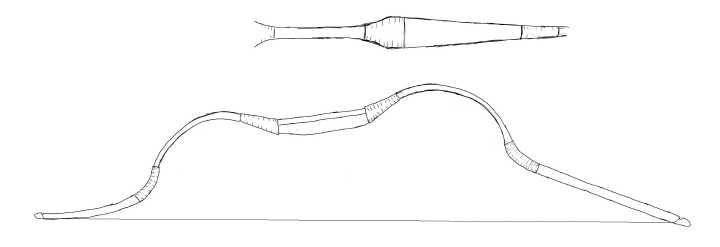
Figure 19. Niya 95MN1M3
Ancient Tibetan Archery Finds
To see if the Miran bows could be associated with the fort, it is useful to compare them to some contemporary Tibetan archery equipment.
Some interesting finds from the era of the Tibetan dominance of Central Asia were found around the fort of Mazar Tagh. This lies about 120 miles north of Khotan on a strategic site overlooking the Khotan River, deep in the Taklamakan desert16.
In the early 20th century, a collection of staffs with votive rags still existed part way up the scarp, indicating the supposed resting place of a saint after which the site was named; Mazar meaning burial and tagh a small hill in Turkic or Persian17. Close by was an earlier Buddhist shrine.
The fort was first excavated by Sir Aurel Stein in 1908 and revisited by him a few years later where he collected some material found by local treasure-hunters. Most of the finds came from rubbish tips formed by the occupants discarding waste over the edge of the scarp, where it piled up protected from the wind and high enough above to river to remain dry. This waste contained a large number of documents, which allowed the fort to be linked to the Tibetan empire and dated to the 8th-9th centuries18. It also contained some arrow shaft fragments and some “ends of wooden bows”, which are obviously siyahs from broken composite bows19.
Arrow Shafts 20
A number of wooden arrow shaft fragments were found at the site. Two of the larger fragments were just over 10 inches long and from the nock end. They tapered from 3/8 to 1/4 in. before the nock. One had traces of circa 5 in. fletchings with a spiral arrangement. Some showed traces of binding and lacquer. Most of the fragments were wood, but one was of cane.
Figure 20. One of the arrow shaft fragments
Siyah M. Tagh. a.0017
A wooden siyah, probably tamarisk wood, with a triangular cross-section survives from a composite bow. A small hole at the tip was possibly for suspension. The nock groove is 2 1/2 in. from the tip and shows evidence of string wear. Lower 5 in. of the siyah is “pared down to take binding, now gone”. Overall length (straight) 12 1/2 in., greatest width 7/8 in., greatest thickness 13/16 in.
Figure 21. M. Tagh. a.0017
Siyah M. Tagh. a.0018
M.Tagh a.0018 is another wooden siyah. The lower 4 1/2 in. has a covering of bark strips, presumably over a sinew binding. Overall length is 11 in. (straight), width 7/8 in. to 3/16 in., thickness 7/8 in. to 5/8 in.
This fragment currently resides in the British Museum.
Figure 22. M. Tagh. a.0018
Siyah M. Tagh. 0321
This is another siyah made from a hard wood with an attached limb backing of sinew. The belly is flattened, back is rounded keel shaped. The tip is flattened and has the nock groove about 1 1/2 in. from the tip. The sinew backing runs part way up the siyah and is bound with fine fibre and painted black. Reportedly extremely well made. Overall length 1 ft. 9 in., siyah length about 13 in., width at centre (presumably the centre of the whole fragment, therefore at the siyah base) 1 1/2 in.
Figure 23. M. Tagh. 03
Discussion
The three siyahs found by Stein are notable in the lack of any bone plates, which were typical of the earlier Hunnic bows and the European Magyar bows of contemporary date. They are of solid wood without any sinew backing or covering. It is likely they were spliced into the limbs.
The three finds have differing limb-siyah angles, M. Tagh. a.0018 having zero angle, but all have gentle curves and the nock some distance from the tip.
The lack of any other bow remains makes determining the bow length a matter of some guesswork, but the siyah lengths of 11-13 in. are shorter than the earlier Hunnic weapons.
The wooden arrow shafts are of fairly typical Central Asian form, with barrelled shafts and slightly bulbous nocks. This form was used over a long period. The lack of complete shafts makes any determination of draw length difficult.
Conclusions
The Miran bows are very useful in providing more information on the development of the composite bow22, although they do not drop neatly into the existing limited categories.
The overall form of the Miran bows is generally Hunnic, but with a number of unusual features.
Overall size and shape
Their overall size is more representative of bows from the first half of the first millennium, bows from the second half of the first millennium generally being shorter. Some of the medieval Mongolian bows were of similar length to the Miran bows.
The asymmetry is another early feature, being common on the Hunnic style bows and unusual by the time of the Mongolian invasions23.
Siyahs
The siyah construction with the core bent and reinforcing strips added is seen in the early finds from Qum-Darya and Khotan, and probably common in the Hunnic bows.
The siyah side plates on one of the bows also have Hunnic roots.
The use of wooden side plates is not recorded from previous archaeological finds. As most finds of early composite bows consist of only the bone plates, bows with wooden side plates or solid wooden siyahs would be archaeologically invisible in most circumstances.
The siyahs are slightly shorter than common for the Hunnic period, but this could be a design feature due to the lack of stiffening bone plates.
Several variants of the Ancient Turkic bows in use in the 6th to 13th centuries lacked siyah plates24. These all differ from the Miran bows in the use of grip side plates.
The 8-9th century siyahs from Mazar-tagh are of a different design. They are solid wood without side plates, sinew backing or spiral wrap, a construction used in the later Mongolian bows. It is assumed these siyahs were spliced into the limbs.
The Mazah Tagh siyahs have a roughly triangular cross-section towards their base, a shape seen in the later Onmnogov bow, but not in most of the medieval Mongolian bows.
The Miran bows have a fairly oval cross-section as the limb joins the siyah. This is seen in some of the Medieval Mongolian bows.
The Mazah Tagh siyahs also differ from the Miran bows in having about a 2 in. distance between the tip and nock groove. This is a typical later feature also seen on the 8th century Moshcheveya Balka bows.
Limbs
The spiralled sinew binding over the complete length of the Miran bows is similar to the Yrzi bow from Syria25. The Yrzi bow only had one layer of sinew wrapping, making the Miran bows unique in having two such layers.
The other bone-reinforced bows from Xinjiang have visible bands of sinew wrap at the ends of the grip and base of the siyah, so are not thought to have a continuous spiral wrapping. In contrast, the earlier Scythian style bows from Subeshi do seem to have been sinew wrapped26.
The large width of the limb at the base of the siyah is unusual. It is possible that this is linked to the lack of stiffening bone plates.
The reinforcing strips on the Miran bow going well down the limb from the siyah base would cause a lack of bend in the outer limb. Similar lack of bend in the outer limbs can be seen in the Hunnic bows from Niya and in the Omnogov bow27, indicated by the lack of set in the outer limbs.
The extra layer of sinew applied to the heavier bow after the spiral wrap was presumably a modification to increase the draw weight after completion.
Grips
The overall shape of the Miran grips differs markedly from the early Hunnic form, which was much longer and with obvious bone plates28. They also substantially differ from the Turkic derived bows with bone side plates of the 6th to 12th centuries.
They appear closer to the much later Mongolian bows, which typically had a bone belly plate reinforcing the grip originating in about the 10th century. An earlier form with a more rectangular plate shape known as the Kimek type dated to the 9th-10th centuries. The Miran bows may significantly predate this so probably do not have a bone belly plates.
The grip shape and lack of visible grip plates probably indicates a different construction to the Hunnic bows (which appear to have had the two limbs spliced together in the grip, the long grips giving a longer splice). It is possible that the core was made in one piece, heat bent with a riser glued to the back. This is comparable to the grip construction of the more recent Chinese composites.
Arrows
The arrows are of the typical Central Asian form with barrelled shaft and bulbous nock, used over a very long period. The lack of any heads removes another source of dating evidence.
More on Dating
As the remains show greater similarity to the Shanshan era Hunnic bows than to the later Tibetan types, it is thought most likely that the bows are of Shanshan date, although a later date with some archaic features is possible.
Acknowledgements
Our thanks to the Silk Road Museum for permission to photograph their bows.
Bibliography
Atex, W. & Menes G., The ‘Omnogov Bow’, JSA-A 38, pp. 71-75.
Beckwith C.I., The Tibetan Empire in Central Asia: A History of the Struggle for Great Power Among Tibetans, Turks, Arabs and Chinese During the Early Middle Ages, Princeton University Press; 1993.
Bergman F. Archaeological Researches in Sinkiang Especially the Lop-Nor Region, Stockholm, 1939
Wang Binghua (Ed) The Ancient Corpses of Xinjiang: The Peoples of Ancient Xinjiang and their Culture, CIP, 1999, ISBN 7-228-05161-0. [English and Chinese]
Brown P.E. ‘A Recently Discovered Compound Bow’, Annales de l’Institut Kondakov, Prague, 1937.
Hall A., ‘Some Well-Preserved Composite Bows’, JSA-A 48, pp. 28-36.
Hall A., ‘The Development of Bone Reinforced Composites’, JSA-A 49, pp. 65-77.
Hill J. E. (trans), The Peoples of the West. http://depts.washington.edu/silkroad/texts/weilue/weilue.html. (A draft translation of the Weilue by Yu Huan).
Hill J. E. (trans), The Western Regions according to the Hou Hanshu. http://depts.washington.edu/silkroad/texts/hhshu/hou_han_shu.html. Translation of ‘Chapter on the Western Regions’ from Hou Hanshu.
Makiko Onishi, Asanobu Kitamoto, ‘Another Silk Road: Qinghai Route’, Silk Road in Rare Books, Digital Silk Road Project, http://dsr.nii.ac.jp/rarebook/07/
Li Qing: GU LOULAN SHANSHAN YISHU ZONGLUN. (Ancient Lou-Lan and Shan-Shan Art Summarize). Beijing, 2005. [Chinese]
Mode, M. and Tubach, J. (Eds), Arms and Armour as indicators of Cultural Transfer, Dr. Ludwig Reichert Verlag, Weisbaden 2006. [English, German and French]
Stein A., Serindia, Oxford, 1921.
Stein A., Innermost Asia, Oxford, 1928.
Whitfield S., The Silk Road: Trade, Travel, War and Faith, British Library Publishing, 2004.
Feng Zhao and Zhiyong Yu (Editors) Legacy of the Desert King: Textiles and Treasures Excavated on the Silk Road, ISAT/Costume Squad Ltd, Hong Kong, 2000, ISBN 962-85691-2-0. [English & Chinese]
Xinjiang Institute of Archaeology et al, ‘Cemetery 3 at the Shu-bash Tomb Area, Shanshan County’, New Achievements in Archaeological Research in Xinjiang between 1990-1996, Xinjiang Institute of Archaeology and the Museum of the Xinjiang Autonomus Region, 1997, ISBN 7-80547-550-4. [Chinese]
Notes
1 Miran fort can be seen on Google Earth at 39º13’36.10”N, 88º58’14.50”E
3 See Hill, The Peoples of the West, notes to section 4.
4 The Chinese did not always have the troops available to retain control. For instance, Shanshan submitted to the Xiongnu (Huns) after being denied help by the Chinese in 46AD. See also Hill, The Western Regions according to Hou Hanshu.
5 See Whitfield, chapter ‘Miran: War and Faith’
6 Whitfield does not give a reason for why travel became more difficult. The likely reasons are lack of security and climatic change. Niya was also abandoned about this time and swallowed by the desert.
7 See ‘Another Silk Road’ for a description of the Qinghai Route.
8 Niya graves 59MNM001, 95MN1M3 and 95MN1M8 contained couples with a single bow. 95MN1M1 contained two males and two bows. 95MN1M4 contained two males, one female and a child and two bows. See The Ancient Corpses of Xinjiang.
9 This could be a misprint for 15-14 centuries B.P., but Miran was unoccupied at this date.
10 The Shanshan period is about 2nd century BC to 4th century AD. Most of the Shanshan remains at Miran are from the end of this period.
11 With all else being equal, a 2 x ⅝ in. bow will be more than twice as stiff as 1 ¾ x ½ in., although this difference would be reduced by the longer siyahs on the heavier bow.
12 Archaeological Researches in Sinkiang, pp. 223-229.
13 See Hall, Some Well Preserved Composite Bows
14 Bergman, Archaeological Researches in Sinkiang, pp. 118-131 and plates XIII and 18. Plate XIIIa shows the contents of the mass grave after excavation. The intact bow is visible to the right side.
15 See Preface of Legacy of the Desert King
16 Mazar-tagh fort can be seen on Google Earth at 38°27'2.12"N, 80°51'46.34"E.
17 Translation by Zagit Davidov.
18 This links with the Tibetan control of Khotan from 792-851 A.D.
19 It is interesting that two of the three siyahs look as if the limbs they were attached to were broken by bending the wrong way. The one that does not show evidence of this is M.Tagh a.0018, which does not have any siyah/limb angle. This might be indicative of some instability in the Tibetan bows causing them to reverse and break.
20 Serindia, Vol 3. p. 1292 and Pl. LI.
21 Innermost Asia, Vol. 3, p. 94 and Pl. VI.
22 Due to the limitations on the numbers of intact bows of this age, most of the work on the evolution of the composite bow has been done using just the bone reinforcement plates.
23 The Silk Road Museum also contains a medieval Mongolian bow of similar length and asymmetry.
24 See Hall, The Development of Bone-Reinforced Composites. These types are known from the finds of bone grip plates only, so the form of the siyahs is not known.
25 See Brown, A Recently Discovered Compound Bow
26 A description of the bow finds in Xinjiang Institute of Archaeology et al, Cemetery 3 at the Shu-bash Tomb Area, Shanshan County states that the outer layer of bow M4 is wrapped in ox sinew.
27 Although much later than the medieval period, this bow appears very similar to the Yuan dynasty bows, even down to the use of a bone grip belly plate.
28 Mode and Tubach contains a number of illustrations of decorated grip plates from Hunnic bows. These plates could not have been covered.